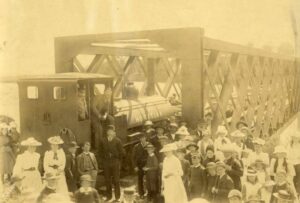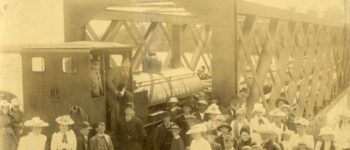1893: Greymouth-Hokitika Line
December 18, 2024
By AHNZ
 Today in history, 18 December, 1893, the Greymouth-Hokitika line was finally opened. Started in the late 1870s much of it had been completed so long ago it was rusting and buckling and the hope of ever seeing a train was a joke.
Today in history, 18 December, 1893, the Greymouth-Hokitika line was finally opened. Started in the late 1870s much of it had been completed so long ago it was rusting and buckling and the hope of ever seeing a train was a joke.
Technically the line had been opened by Premier Seddon in June but governments love to open things all over again; It’s good PR.
Completion that year of the Taramakau Bridge might be the reason for the dual dates. It is still in service today and replaced a cable that ferried goods over the river in a cage.
How to explain what took so long? My speculation is that holding up the rail project held Hokitika to ransom. Whoever ran that old cage and wooden tramway and the hotel must have had a license to print money. It was a bottleneck in New Zealand’s bloodstream and nobody who controlled that would want to give it up without something good in return. I think there must be an interesting story to be told here that State history does not record.
“The tramway was broken at the Taramakau where another means of crossing had to be found. This job was taken care of by a steam-powered cable car called ‘The Cage’. That’s the way it had to be until a road-rail bridge came along for this river on 18 December 1893. This bridge was not replaced until 22 July 2018 but remains in service as a rail bridge with its distinctive red paint.” – 1877: The Greymouth and Kumara Tramway, AHNZ
“Railway construction commenced in the early 1880s and the Greymouth-Hokitika line was opened on 18 December 1893.” – An Encyclopaedia of New Zealand, A. H. McLintock (1966)
“In 1886, work restarted, and the continued attempts from Kumara residents to have the line’s route changed failed to force an alteration to the plans. Work progressed steadily over the next few years, and on 18 December 1893, the complete line from Hokitika to Greymouth opened.” – Wiki
“As the West Coast gold rush flowed south in 1865, Lake Mahinapua became part of an inland water highway – up Mahinapua Creek, across the lake, 1.5 kilometres overland to the Totara Lagoon and down to Ross. Vessels on the creek and lake included small steamers…extension of the railway south of Hokitika in 1905 brought an end to the commercial use of the waterway. Goods could be carried more quickly and cheaply by rail, while passengers also enjoyed the new form of transport.” – Information panel at Lake Mahinapua, DOC. AHNZ Archive (2022)

I believe I have identified in our economic history here a case of the tyranny of the status quo. There will have been a Perverse Incentive here not to build the Greymouth-Hokitika Line at all or to at least delay it.
It’s a similar example to another Today In History transport infrastructure story: Christchurch International Airport, also est. 18 December but in 1920. An international airport seems to have been delayed because it would greatly disrupt the vested interests of the traditional sea ports. Ref. 1950: Christchurch International Airport, AHNZ
Before rail there was a thriving transport highway of water, horse trams, and flying cableway. There were shops, tolls, warehouses, jobs, hotels and whole settlements that relied upon or pivoted on this transport network. It was not in their interests to have this old Colonial network wiped off the board by the new disruptive technology even if rail efficiency was for the greater public good. Control over where people and goods flowed wasn’t something to give up lightly and those who had it would have been in a position to influence politicians from taking away their particular seat at the table.
Looser: Lake Mahinapua itself, for example, used to be a busy busting place of humans passing through. Now it was bypassed.
Winner: Mahinapua Hotel. Newly (1905) established when the railway came and in prime position to service a mass of travellers who would not have passed this way before
Looser: The driver of the Greymouth to Kumara Tramway whose business would have been cut by the new railway
Looser: The Tramway Tavern, Taramakau Bridge. Before the road/rail bridge it was a major node for everything crossing the river. Like an airport but privileged by being the end of a big wire. A place to talk, plan, decide, and observe everything and everyone coming and going. Today it’s an Air B&B called Riverstone House.
Richard Seddon, the new Prime Minister, who had just won a landslide victory at the ’93 election, was probably in the middle of broking these new transport powers. He and his family had doubtless come ‘home’ to Kumara for Christmas so he was right where he needed to be to seal all the deals. Ref. Greymouth Industrial Exhibition…formally opened by..Seddon…20 December. West Coast Times (1893,) Papers Past
This is an angle on the story of the railway that Statist history cannot tell because it’s state-supporting rather than cynical toward it as the Anarchist History of New Zealand must be. It’ not simply the story of happy people with ribbons being cut and new transport technology arriving. It’s a story about ‘how the sausages get made’ as Bismarck put it.
To visit Lake Mahinapua today is quite exciting though with this history in mind. Looking at the rusting old steamboat bits on the shore it’s possible to imagine how and why it was once so busy but now so quiet.
—
Image ref. Wikipedia
Image ref. Taramakau bridge (south) showing where the road once met. AHNZ Archives (2024)
 Like Comment Share
Like Comment Share





